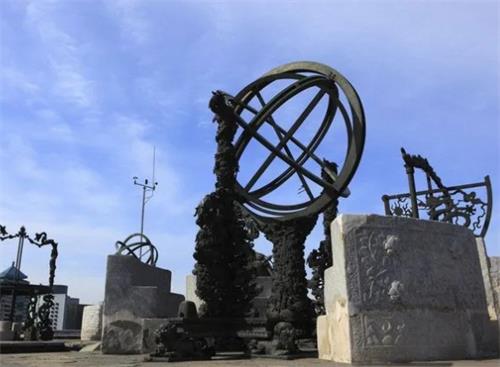
In ancient times, astronomy was not merely a reflection of human curiosity about the universe; it was a practical science tied to survival. More than five centuries ago, the Chinese built the Ancient Observatory in Beijing, laying the foundation for continuous astronomical observation.This observatory witnessed in-depth studies of astronomical phenomena during the Ming and Qing dynasties, becoming an important "laboratory" for ancient explorations of cosmic mysteries. It stands as a crystallization of ancient science and technology, offering us a window into the wisdom of our ancestors.
The construction of the Ancient Observatory dates back to the Ming dynasty. As the royal center for astronomical observation at the time, the facility housed highly precise instruments and maintained continuous observation of the night sky for 487 years. Located in the heart of the city, the observatory resembles an ancient fortress surrounded by modern skyscrapers. Its rooftop stands 14 meters high, offering an unobstructed 360-degree view, which ensured accurate astronomical observations. More importantly, the rooftop holds eight bronze-cast astronomical instruments, each weighing two to three tons, representing the most advanced technology of the era. These instruments were designed with simplicity and precision, reflecting the profound knowledge of ancient astronomy.
It features a sphere over two meters in diameter, simulating the distribution of stars on the celestial sphere. This sphere is embedded with 1,888 stars, categorized into six different brightness levels. It visually represented the ancient understanding of the universe, functioning as a "panoramic model of the cosmos," assisting astronomers in identifying constellations and converting spherical coordinates.
Another crucial instrument was the Equatorial Armillary Sphere. Composed of multiple rings—including the meridian circle, hour circle, and equatorial circle—this instrument could rotate to measure the celestial coordinates of stars. It functioned like a "celestial map," helping ancient astronomers locate stars in the sky, particularly for observing stars beyond the Sun and distant celestial bodies.
To track the Sun's movement, ancient astronomers also designed the Ecliptic Armillary Sphere. Consisting of several rings, it was primarily used to measure the paths of the Sun and planets. The ecliptic represents the Sun's annual path across the sky, and this instrument helped ancient people grasp the Sun's changing patterns. Based on these patterns, they established the Twenty-Four Solar Terms, which guided agriculture and daily life.
Additionally, the Horizon Ring was an indispensable device. It featured a horizon circle over two meters in diameter and was used to measure the azimuth of celestial bodies on the horizon. Through this instrument, ancient astronomers could precisely determine the directions in which the Sun and stars rose and set. The Altazimuth Instrument went even further, measuring both the horizontal and vertical positions of celestial objects. This instrument utilized Arabic numerals for its scales, marking a step toward greater precision in ancient astronomy.
The Declination Instrument (also known as the Quadrant) showcased the precision and versatility of ancient astronomical devices. Its three-dimensional movement mechanism was similar to the mount of modern telescopes, enabling precise measurement of the angular distance between any two stars—a critical feature for drawing accurate star maps.
Moreover, the Quadrant helped astronomers determine the altitude of celestial bodies by measuring their angular height above the horizon. The Armillary Dial could measure both the azimuth and altitude of celestial bodies, aiding in the prediction of the paths of the Sun, Moon, and stars.
At the base of the Ancient Observatory, one could also find the Gnomon. This simple yet effective tool was used to determine seasonal changes by measuring the shadow cast by the Sun. Particularly during the Winter Solstice, ancient astronomers accurately identified the shortest day and longest night of the year by measuring changes in shadow length.
These astronomical instruments allowed ancient astronomers to observe the night sky with precision, develop calendars, and understand the passage of seasons and time based on celestial changes. The sophistication of these instruments and the observatory itself highlights the advanced development of ancient science and technology. Today, they serve as invaluable legacies, offering insight into the wisdom of the past. The Ancient Observatory was not only the heart of astronomical research in its time but remains an important window through which we study ancient science and culture today.

Ancient Greek Theaters
Unveiling the Mystery of Ancient Greek Theaters: The Acoustic Wonder of the Epidaurus Theater
The Epidaurus Theater, located near Athens, Greece, is a well-preserved ancient theater built in the late 4th century BCE.

Pygmalion,Galatea
From Sculpture to True Love: The Miraculous Romance of Pygmalion and Galatea
In a peaceful town on the island of Cyprus, there lived a sculptor named Pygmalion. Gifted with extraordinary talent, his sculpting skills were admired by many.

Maya Civilization
Six Pieces of Evidence for the Mysterious Disappearance of the Maya Civilization
The Maya civilization remains one of the most mysterious and astonishing civilizations in Earth's history. The Maya made remarkable achievements in astronomy, mathematics, architecture, and medicine.


